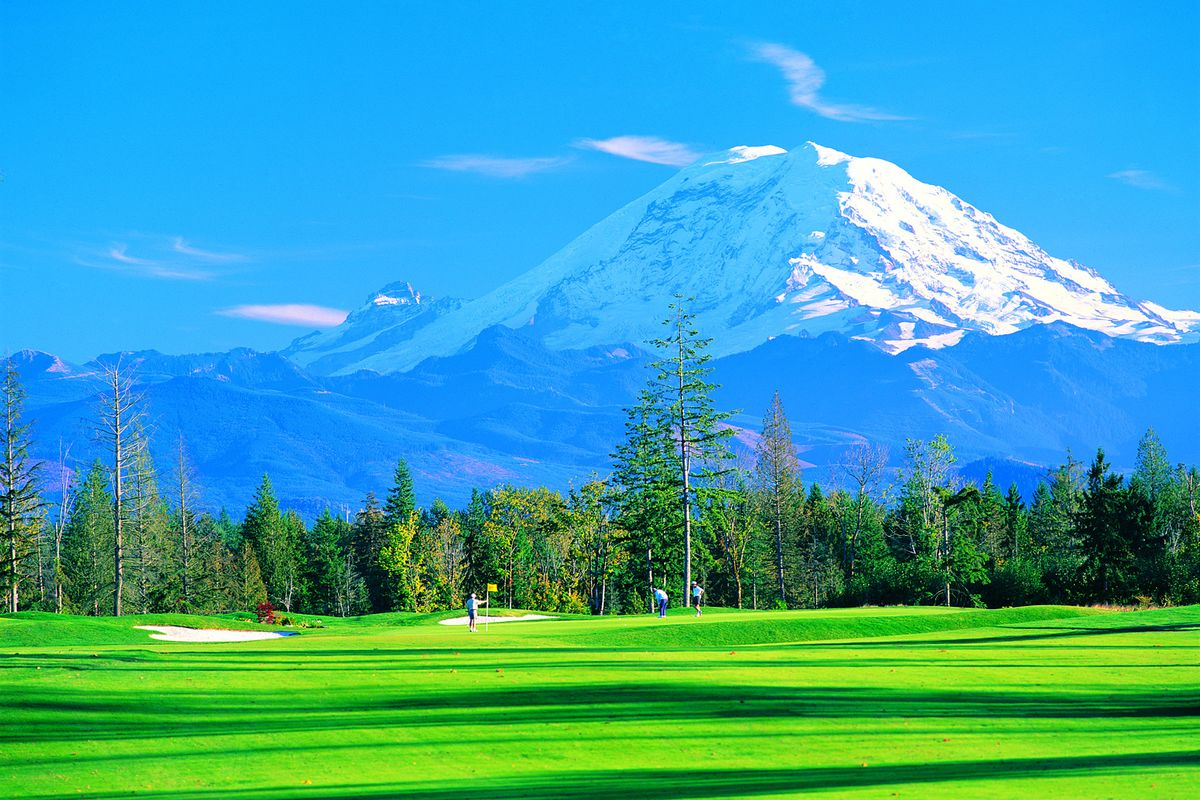Golf: Druids Glen serves up satisfaction with polish and picturesque layout

When playing a golf course for the first time you always come away with at least one valid gripe, right? Too expensive. Mundane layout. Too tough. Not tough enough. Dreadful greens. Shoddy fairways. Visually unappealing.
You won’t encounter that problem at Druids Glen. The course could probably offer a satisfaction guarantee and not have to worry about grumbling customers. That’s coming from a guy who turned a 20-minute drive to the course into a 70-minute exploration – I’m blaming MapQuest – and then played so-so golf for 18 holes.
The course offers a little of everything – water, bunkers, tree-lined fairways and creative design – and it comes with a view. Mount Rainier serves as a stunning backdrop on a cloudless July morning.
“The words we use are a championship caliber course at competitive pricing,” said Lake City High graduate Jeff Schuh, the course’s golf and tournament manager. “The biggest thing I hear from people is the great view and setting and it’s a solid golf course. You don’t go around the course feeling like you’re playing the same hole over and over. You’re using every club in the bag and getting a different challenge based on the hole you’re playing.”
Our threesome played from the championship tees, spanning 6,514 yards. The tournament tees extend the length to 7,146 yards. There’s a world of difference between the two.
“You don’t have to be so perfect (from the championship tees),” Schuh said, “but when we move it back for tournaments or with our men’s club the scores shoot up.”
The par 3s are great holes, from any of the four tee boxes, with water coming into play on three of the four. The fourth measured 202 yards with a wavy green and a well-placed bunker in front.
I hit an 8-iron, 7-iron, 6-iron and 5-iron on the par 3s. I should have hit 8-iron, 7-iron and two 5-irons.
On No. 3, which required a carry of nearly 195 yards over a pond to a pin tucked in the back left corner, I visited the water with a semi-chubby 6-iron and made double bogey.
“One is downhill, one is straight-on with water left and right, one has water left,” Schuh said. “There’s no water on No. 6, but there’s a bunker in front. You’re not just stepping up and hitting pitching wedge or 9-iron four times on the par 3s.”
Several other holes were eye-catchers.
No. 7 is the classic risk-reward par 4 at 281 yards. It features a narrow direct-line landing area and an elevated green protected by a couple of sand traps. If you miss right, trees await. If you miss left, you’ll usually end up with an awkward, uphill second shot to a small target. Speaking from experience: If you miss wide left, you’ll yank another ball from your bag and try to do better the next time.
No. 2 is a short, 461-yard par 5 with Mount Rainier in the background when the weather cooperates. The hole isn’t overly difficult, if your drive is on the mark. It’s often a 6- or 7-iron home for a crack at eagle. From the tips, though, it’s usually a low iron/hybrid or fairway wood over water to an angled green.
No. 15 is a 433-yard par 4 with a sizable fairway but big trouble if you spray it too far left or right. The hole’s complexion changes with a well-struck drive that reaches a sharp downhill slope roughly 265 yards from the tee and feeds down to an approach from wedge distance. Drives remaining on the upper plateau require a middle iron to find the green.
The 18th is a 533-yard par 5 that is reachable in two with a pair of quality shots, but not if your drive trickles into a culvert at the outset of a water hazard on the left.
The hole will yield birdies and a rare eagle as well as a ‘7’ to the unnamed player who found a culvert.
Rates vary throughout the week, but there are Monday and Tuesday specials for $39 with GPS-equipped carts. The course was in outstanding condition, particularly the greens.
“We’ve found what works,” Schuh said. “We have everything so dialed in that one year is the same as the next, but we keep improving on the little things.”